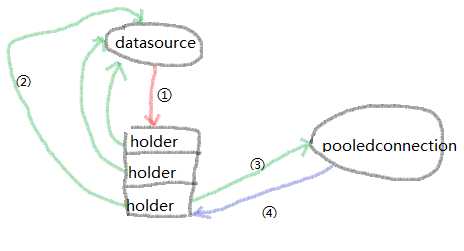Druid数据库连接池源码分析
Posted garfielder007
tags:
篇首语:本文由小常识网(cha138.com)小编为大家整理,主要介绍了Druid数据库连接池源码分析相关的知识,希望对你有一定的参考价值。
Druid不仅仅是一个数据库连接池,还有很多标签,比如统计监控、过滤器、SQL解析等。既然要分析连接池,那先看看DruidDataSource类
getConnection方法的实现:
@Override
public DruidPooledConnection getConnection() throws SQLException {
return getConnection(maxWait);
}
public DruidPooledConnection getConnection(long maxWaitMillis) throws SQLException {
init();
if (filters.size() > 0) {
FilterChainImpl filterChain = new FilterChainImpl(this);
return filterChain.dataSource_connect(this, maxWaitMillis);
} else {
return getConnectionDirect(maxWaitMillis);
}
}
返回的是一个DruidPooledConnection,这个类后面再说;另外这里传入了一个long类型maxWait,应该是用来做超时处理的;init方法在getConnection方法里面调用,这也是一种很好的设计;里面的过滤器链的处理就不多说了。
public void init() throws SQLException {
if (inited) {
return;
}
final ReentrantLock lock = this.lock; // 使用lock而不是synchronized
try {
lock.lockInterruptibly();
} catch (InterruptedException e) {
throw new SQLException("interrupt", e);
}
boolean init = false;
try {
if (inited) {
return;
}
init = true;
connections = new DruidConnectionHolder[maxActive]; // 数组
try {
// init connections
for (int i = 0, size = getInitialSize(); i < size; ++i) {
Connection conn = createPhysicalConnection(); // 生成真正的数据库连接
DruidConnectionHolder holder = new DruidConnectionHolder(this, conn);
connections[poolingCount] = holder;
incrementPoolingCount();
}
if (poolingCount > 0) {
poolingPeak = poolingCount;
poolingPeakTime = System.currentTimeMillis();
}
} catch (SQLException ex) {
LOG.error("init datasource error, url: " + this.getUrl(), ex);
connectError = ex;
}
createAndLogThread();
createAndStartCreatorThread();
createAndStartDestroyThread();
initedLatch.await();
initedTime = new Date();
registerMbean();
if (connectError != null && poolingCount == 0) {
throw connectError;
}
} catch (SQLException e) {
LOG.error("dataSource init error", e);
throw e;
} catch (InterruptedException e) {
throw new SQLException(e.getMessage(), e);
} finally {
inited = true;
lock.unlock(); // 释放锁
if (init && LOG.isInfoEnabled()) {
LOG.info("{dataSource-" + this.getID() + "} inited");
}
}
}
我这里做了删减,加了一些简单的注释。通过这个方法,正好复习一下之前写的那些知识点,如果感兴趣,可以看看我之前写的文章。
这里使用了lock,并且保证只会被执行一次。根据初始容量,先生成了一批数据库连接,用一个数组connections存放这些连接的引用,而且专门定义了一个变量poolingCount来保存这些连接的总数量。
看到initedLatch.await有一种似曾相识的感觉
private final CountDownLatch initedLatch = new CountDownLatch(2);
这里调用了await方法,那countDown方法在哪些线程里面被调用呢
protected void createAndStartCreatorThread() {
if (createScheduler == null) {
String threadName = "Druid-ConnectionPool-Create-" + System.identityHashCode(this);
createConnectionThread = new CreateConnectionThread(threadName);
createConnectionThread.start();
return;
}
initedLatch.countDown();
}
这里先判断createScheduler这个调度线程池是否被设置,如果没有设置,直接countDown;否则,就开启一个创建数据库连接的线程,当然这个线程的run方法还是会调用countDown方法。但是这里我有一个疑问:开启创建连接的线程,为什么一定要有一个调度线程池呢???
难道是当数据库连接创建失败的时候,需要过了指定时间后,再重试?这么理解好像有点牵强,希望高人来评论。
还有就是,当开启destroy线程的时候也会调用countDown方法。
接着在看getConnection方法,一直调用到getConnectionInternal方法
DruidConnectionHolder holder;
try {
lock.lockInterruptibly();
} catch (InterruptedException e) {
connectErrorCount.incrementAndGet();
throw new SQLException("interrupt", e);
}
try {
if (maxWait > 0) {
holder = pollLast(nanos);
} else {
holder = takeLast();
}
} catch (InterruptedException e) {
connectErrorCount.incrementAndGet();
throw new SQLException(e.getMessage(), e);
} catch (SQLException e) {
connectErrorCount.incrementAndGet();
throw e;
} finally {
lock.unlock();
}
holder.incrementUseCount();
DruidPooledConnection poolalbeConnection = new DruidPooledConnection(holder);
return poolalbeConnection;
我这里还是做了删减。大体逻辑是:先从连接池中取出DruidConnectionHolder,然后再封装成DruidPooledConnection对象返回。再看看取holder的方法:
DruidConnectionHolder takeLast() throws InterruptedException, SQLException {
try {
while (poolingCount == 0) {
emptySignal(); // send signal to CreateThread create connection
notEmptyWaitThreadCount++;
if (notEmptyWaitThreadCount > notEmptyWaitThreadPeak) {
notEmptyWaitThreadPeak = notEmptyWaitThreadCount;
}
try {
notEmpty.await(); // signal by recycle or creator
} finally {
notEmptyWaitThreadCount--;
}
notEmptyWaitCount++;
if (!enable) {
connectErrorCount.incrementAndGet();
throw new DataSourceDisableException();
}
}
} catch (InterruptedException ie) {
notEmpty.signal(); // propagate to non-interrupted thread
notEmptySignalCount++;
throw ie;
}
decrementPoolingCount();
DruidConnectionHolder last = connections[poolingCount];
connections[poolingCount] = null;
return last;
}
这个方法非常好的诠释了Lock-Condition的使用场景,几行绿色的注释解释的很明白了,如果对empty和notEmpty看不太懂,可以去看看我之前写的那篇文章。
这个方法的逻辑:先判断池中的连接数,如果到0了,那么本线程就得被挂起,同时释放empty信号,并且等待notEmpty的信号。如果还有连接,就取出数组的最后一个,同时更改poolingCount。
到这里,基本理解了Druid数据库连接池获取连接的实现流程。但是,如果不去看看里面的数据结构,还是会一头雾水。我们就看看几个基本的类,以及它们之间的持有关系。
1、DruidDataSource持有一个DruidConnectionHolder的数组,保存所有的数据库连接
private volatile DruidConnectionHolder[] connections; // 注意这里的volatile
2、DruidConnectionHolder持有数据库连接,还有所在的DataSource等
private final DruidAbstractDataSource dataSource;
private final Connection conn;
3、DruidPooledConnection持有DruidConnectionHolder,所在线程等
protected volatile DruidConnectionHolder holder;
private final Thread ownerThread;

对于这种设计,我很好奇为什么要添加一层holder做封装,数组里直接存放Connection好像也未尝不可。
其实,这么设计是有道理的。比如说,一个Connection对象可以产生多个Statement对象,当我们想同时保存Connection和对应的多个Statement的时候,就比较纠结。
再看看DruidConnectionHolder的成员变量
private PreparedStatementPool statementPool;
private final List<Statement> statementTrace = new ArrayList<Statement>(2);
这样的话,既可以做缓存,也可以做统计。
最终我们对Connection的操作都是通过DruidPooledConnection来实现,比如commit、rollback等,它们大都是通过实际的数据库连接完成工作。而我比较关心的是close方法的实现,close方法最核心的逻辑是recycle方法:
public void recycle() throws SQLException {
if (this.disable) {
return;
}
DruidConnectionHolder holder = this.holder;
if (holder == null) {
if (dupCloseLogEnable) {
LOG.error("dup close");
}
return;
}
if (!this.abandoned) {
DruidAbstractDataSource dataSource = holder.getDataSource();
dataSource.recycle(this);
}
this.holder = null;
conn = null;
transactionInfo = null;
closed = true;
}
通过最后几行代码,能够看出,并没有调用实际数据库连接的close方法,而只是断开了之前那张图里面的4号引用。用这种方式,来实现数据库连接的复用。
from: https://www.cnblogs.com/cz123/p/8117146.html
以上是关于Druid数据库连接池源码分析的主要内容,如果未能解决你的问题,请参考以下文章
